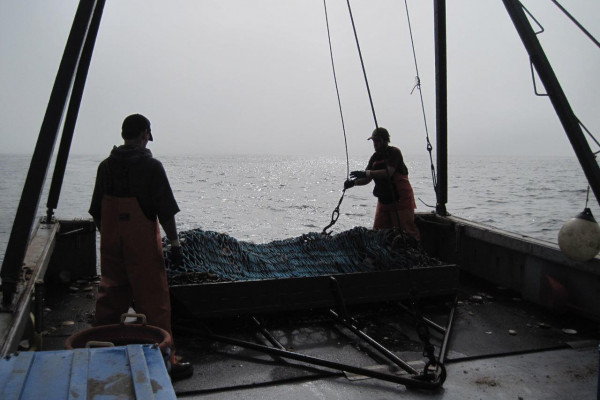
Managers are deciding what to do with a possible bonanza of small scallops. File photo
By Seth Rolbein
They have a name: Peter Pan scallops.
And why?
Because like the famous character, they won’t grow up.
But these scallops don’t live in Never Never Land. They reside in a place called Nantucket Lightship South, roughly 20 miles east and 60 miles south of the elbow of the Cape; take the Great South Channel (rather than the second star to the right), and straight on until morning.
Why won’t they grow up?
Scientists and fishermen have more than one theory, but most agree on a few factors:
These scallops, all born as part of the 2012 year class, settled in water much deeper than typical scallop grounds, around 35 fathoms (210 feet) down, which means that they might not be getting as much nutrient to feed on. Plus, the set that year was phenomenal; packing many animals close together might be another reason why they are stunted.
When researchers say “many animals,” they really mean it. In 2019 surveys, it appears that the biomass of scallops in this one area about 10 square miles (though the big concentration is in roughly four square miles), is more than 35,000 metric tons, a weight that doesn’t include shells, only the little round bodies we eat. That translates into more than three billion animals – with a ‘b’.
Early on, people didn’t even realize that these Peter Pan scallops existed, despite taking regular surveys in the general area. That’s because the animals were small enough to pass right through four-inch rings that comprise scallop dredges, designed for just that purpose, to let smaller animals with no commercial value stay on the bottom while catching bigger shells.
But then scientists noticed a strange phenomenon, what looked like a brown plume or cloud in the water. On closer look, the cloud was millions of baby scallops.
Dr. Bill DuPaul, a retired professor from the Virginia Institute of Marine Sciences, was working on that survey in July, 2013, and remembers millions of baby scallops literally sticking to the hardware of the dredge as it came out of the water. “They were too small to actually get caught in the dredge itself, but there was an unbelievable amount,” he recalls.
Federal regulators kept the Nantucket Lightship South deepwater site off-limits to commercial fishing for years, hoping the Peter Pans would finally grow up enough to become a commercial bonanza for the fleet. There has been some slow but sporadic growth measured, but now, seven years old, the animals still are very small, barely marketable, not bigger than most three- or four-year old scallops.
And here’s the rub: Typically scallops don’t live much longer than nine years, so if these Peter Pans follow that rule (who knows if they will, given their juvenile nature), a huge biomass of scallops will be lost. Small scallops are not as valuable as big scallops, but they still are great eating, still worth something though harder to process, and to let them just turn to gray meat, as happens to old scallops, seems like a huge waste.
There have been a handful of ideas about how to take advantage of this baby bonanza.
Some have advocated allowing scallopers to go in there and harvest hard, take what they can and make up for what would be a low commercial price with more volume. After all, what’s to lose? There are so many animals there, and the danger of old age is great, so why not just go in?
Others have argued that this could be a great opportunity for scientific research and experimentation: How about trying to gather and carefully move tens of millions of live animals to another location where they might grow better? This has been done successfully in other parts of the world, they say, and even if only a fraction survive and mature, the economic windfall would be huge.
Still others believe that the right move is to be more conservative: Take a good-sized harvest this year, say six million pounds, but leave the bulk for at least one more year. Maybe thinning them will help them grow. Maybe they’ll naturally, if slowly, get big enough so their commercial value next year will far surpass this year.
The scallop industry is considered the most lucrative of all the fisheries, and in many ways the best-managed. That’s no coincidence; funding for research and science that informs better management decisions exists in large part because the industry itself can afford to fund annual investigations, setting aside a small slice of big days. And so these issues have been hashed out in multiple public forums, all of which are pointing toward decisions at the New England Fishery Management Council meeting in early December.
As it looks now, the conservative option has the inside track: Harvest some now. Chart what kinds of prices they fetch. Quantify how the rest of the area evolves over the next 10 months or so. See if the stocks remains healthy. Measure to see if they continue to grow even just a bit. Assess whether harvesting more next year, when other scallop areas are not expected to be a fertile as in the past, will help the industry stay balanced and maintain volume.
Decisions reached are expected to be implemented in time for the next scallop season, which begins April 1, 2020. In which case, if fisheries management follows the story line of famous fiction, a whole lot of Lost Boys will begin coming home from Never Never Land.
